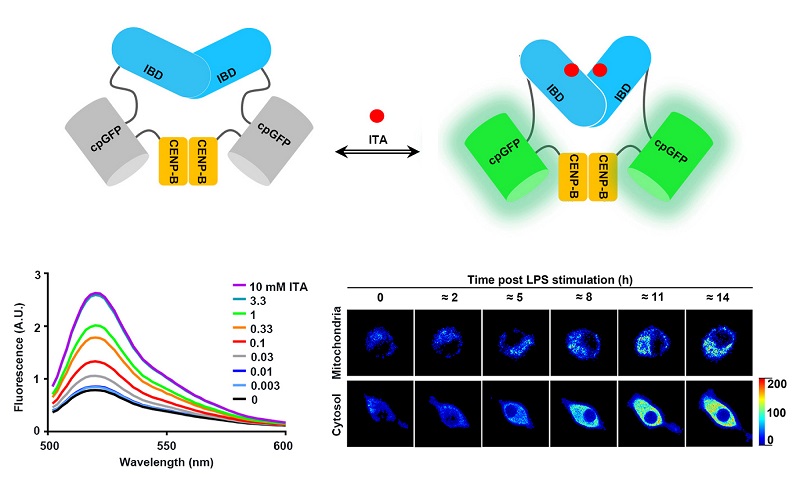A genetically encoded fluorescent biosensor for detecting itaconate in live cells
Itaconate is the most abundant metabolite produced by macrophages during inflammatory activation. The mitochondrial enzyme aconitate decarboxylase 1 (ACOD1, also known as IRG1) highly expressed in lipopolysaccharide (LPS)-stimulated macrophages, generating massive itaconate from cis-aconitate and the mitochondrial itaconate is exported to cytosol to exert its biological functions. Remarkably, our recent study demonstrated that itaconate-mediated alkylation of TFEB, a key transcription factor controlling lysosomal biogenesis, promotes the antibacterial ability of macrophages (Molecular Cell 2022; PMID: 35662396). Despite itaconate can be detected by liquid chromatography-mass spectrometry analysis, a method for real-time monitoring itaconate dynamics with spatiotemporal resolution in live cells remains undeveloped.
A protein-based genetically encoded fluorescent sensor usually consists of a fluorescent protein and a sensing domain. When a target molecule binds to the sensing domain, it changes the conformation of the sensor, resulting in the change of the sensor's fluorescent properties, for example brightness and fluorescence lifetime at a particular excitation/emission wavelength pair. Basing on these coupling events, changes of metabolite concentration can be monitored by detecting the changes of the sensor's fluorescent properties using a fluorescence microscope or a flow cytometer.
Recently, a study published in Nature Communications by Dr. LI Xinjian's group reported the development of a highly responsive, genetically encoded itaconate fluorescent biosensor, referred to as BioITA (biosensor for itaconate). BioITA is initially constructed by coupling a circularly permuted green fluorescent protein (cpGFP) into an itaconate-binding domain (IBD) derived from ItcR, one of bacterial LysR-type transcriptional regulator (LTTR) family proteins, with further optimizations. BioITA allows precise and convenient real-time detection of itaconate dynamics in subcellular compartments of activated macrophages, thereby providing a powerful tool for itaconate detection and bioimaging.

Figure. Schematic drawing of the itaconate biosensor BioITA. BioITA is capable of detecting itaconate with subcellular resolution in living macrophages.
Article link: https://www.nature.com/articles/s41467-022-34306-5
Contact: LI Xinjian
Institute of Biophysics, Chinese Academy of Sciences
Beijing 100101, China
Email: lixinjian@ibp.ac.cn
(Reported by Dr. LI Xinjian's group)

